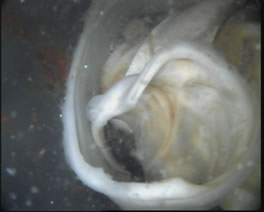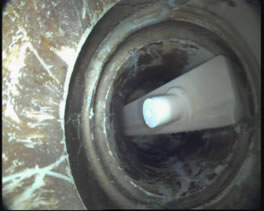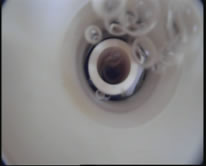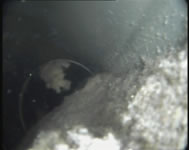
Debris in an interconnecting pipe
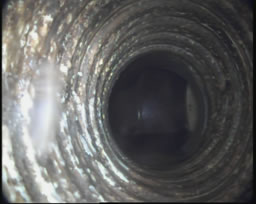
Corrugated pipe and biofilm
Managing spas: design and operation
With the help of specialist camera technology Robbie Phillips has spent a great deal of time inspecting the pipework of commercial spas from the inside. Sometimes the picture revealed is one of potentially life-threatening flaws in spa design and operation.

Debris in an interconnecting pipe

Corrugated pipe and biofilm
As an established consultant that frequents commercial overflow spas, I have regularly used camera technology to investigate the condition of spa pipes during visits. There has long been suspicion that infections in spas can be traced back to the condition of pipes and research shows that there are three major concerns in the design and operation of spa facilities.
Spas present an operator with specific problems that contribute to a high-risk facility: low volume, relative high bathing load per volume of water, nutrient in the form of cosmetics, body fats, high temperature and water as a transmission agent. As a consequence, there is the potential for bacteria to multiply rapidly if the chemical parameters are not adhered to constantly and precisely.
The reality of this situation is that if these parameters are being compromised – perhaps as a result of the automatic dosing system not operating correctly or the plant operator not being given the training required to detect and recognise a problem – the spa could be endangering its clients through organic contamination.
Research into organic contaminations
Using Dart Systems camera technology, we have now been able to further investigate the condition of pipes and, together with 3M Biotrace bio-swabbing for real-time contamination detection, whereby water and surfaces can be quickly tested for organic contamination, we can show the results of poor maintenance and testing.
Images captured in fully functioning, operational spas [see pictures] reveal debris in interconnecting pipes, a spa’s corrugated pipes and biofilm, and blocked spa pipes. We can also demonstrate what a clean spa pipe should look like!
The major faults
There are three major faults:
Recognising the signs of biofilm
While camera images and bio-swabbing can give definitive evidence, there can be telltale signs that often indicate the presence of biofilm. These can be present individually or in combination:
Pipe solutions
There are many psychological, physiological and therapeutic benefits associated with soaking in warm-water spas but we want to keep it this way by ensuring correct maintenance and management.
The following solutions are based on practical observations and must be conducted in line with appropriate risk assessments and safe risk controls. They should be applied together alongside the relevant best practice advice from the Swimming Teachers’ Association, the Pool Water Treatment Advisory Group (PWTAG) and the Health Protection Agency (HPA, now part of Public Health England).
Robbie Phillips is the STA’s pool plant expert and is a regular contributor to the Leisure Review.
Details of the STA’s pool plant management courses and best practice guidance can be found online at www.sta.co.uk© Copyright of all material on this site is retained by The Leisure Review or the individual contributors where stated. Contact The Leisure Review for details.
![]() Download a pdf version of this article for printing
Download a pdf version of this article for printing
